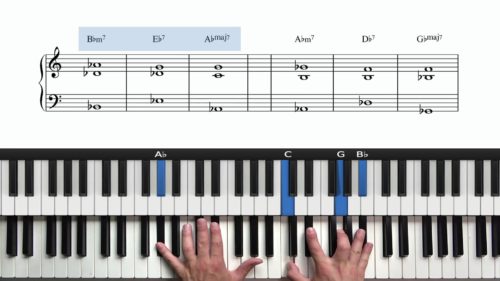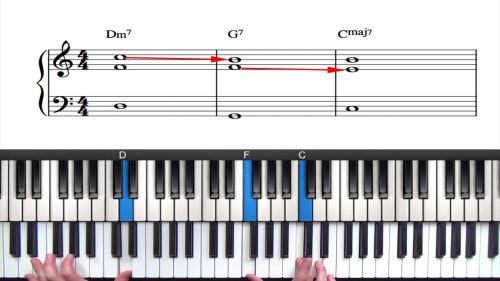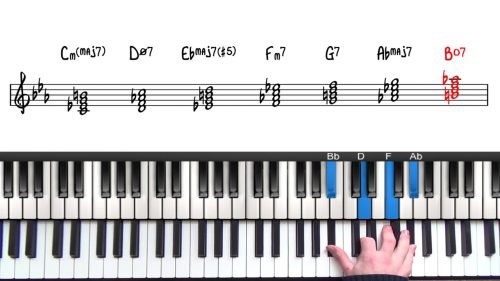“Moon River” – Learning The B Section
Welcome to the 2nd lesson in our course on reading lead sheets for beginner jazz piano players. In this lesson, we delve into the second section of the beautiful jazz standard “Moon River”.
Overview of 3-Note Spread Voicings
We revisit the A Section to review 3-note spread voicing technique. We start by playing the roots of the chord in our left hand, the melody in our right hand, and focusing on the selection of the 3rds and 7ths somewhere in between.
Different voicing techniques are demonstrated and we highlight the creative freedom available to you as the arranger.
Voicing Techniques & Melody
We explore techniques for adding dynamism to our playing, such as playing the notes of the chord in unison versus adding subtle movement between the notes of the chord.
We then examine how the most appropriate chord voicing can often be determined by the melody. We use the repeating A-7 as an example.
Understanding 2-5 Progressions
We introduce the concept of the 2-5 progression and we examine where this common progression appears in the tune “Moon River”. We pay special attention to the 3rds and 7ths of chords to ensure smooth transitions in our 2-5 progressions.
In the next lesson we incorporate the C section and also discuss the form of the tune. You will learn why understanding the form is crucial for quick and effective memorisation of jazz standards.
Practice Tips
-
Isolate challenging sections, particularly the quick 2-5 progressions on the second line of the B Section. Practice this section slowly and accurately to build proficiency.
-
Practice counting the 3/4 time signature. This is particularly useful for establishing the correct rhythmic placement when there are 2 chord per measure.
-
Listen to lots of recordings of "Moon River" to gain inspiration for how the melody can be phrased.
-
Remember that the lead sheet is just a rough interpretation of the song and we have creative freedom to interpret and embellish the melody and to add our own personal touch.







So far really enjoying and getting a lot from these lessons. Thanks so much!
Hey Paul 👋
Thanks for letting me know and I’m glad you are enjoying the course.
I think you will also enjoy the other courses in our “Lead Sheet Fundamentals” Learning Path:
pianogroove.com/syllabuses/lead-sheet-fundamentals/
These courses are designed to build strong foundations in terms of reading lead sheets and playing spread voicings which will prepare you for the more advanced jazz standard studies on the website.
Talk soon,
Hayden
I started to practice the 2-5-1 exercises in parallel with Moon River but a theory question stumped me: the key signature of Moon River appears to be C, so a 2-5-1 progression is D minor – G7 – C Major. E7 is a third above C, while F# is a 4th above C, which confuses me. So my basic questions are:
> What are these 2-5-1 progressions based on if not the key signature?
> Starting in bar 13, there are several 2-5 patterns, e.g. F#m7(b5) –> B7, then Em7 –> A7. If F#m7 is the ii chord (minor), that implies that the I chord is E?
> Similarly, if Em7 is the ii chord, that implies that the I chord is D?
> How do these 2-5 patterns relate to the key signature or melody?
Hi Rico,
Great question!
These 2-5-1 progressions are used to approach the main diatonic 7th chords in the key of C major.
The 2-5-1 progression into E-7 can be viewed as a 2-5-1 into the iii-7 chord in the key of C major which is E-7.
A 2-5-1 in E- would be F#-7 to B7, and then to E-7 – which is exactly what we see on the lead sheet.
This then starts a new 2-5-1 into the ii-7 chord in the key of C Major, which is D-7. So that would be E-7 to A7 to D-7. And finally, this starts a 2-5-1 into the ‘home base’ or the ‘tonic’, which is C major. So the final 2-5-1 is D-7, G7, and Cmaj7.
When playing jazz standards, it’s very common to have chords that are outside of the key. So in this case, B7, and A7 are not in the key of C major, and these dominant chords are called “secondary dominant chords” which are used to create interesting harmony and cadences into the main diatonic 7th chords. The F#-7 is simply the related ii-7 chord which creates a full 251 into E-7.
So to answer your question, always look at where the 251s are resolving, in this case E-7 (iii-7 chord in C major), D-7 (ii-7 chord in C major), and Cmaj7 (Imaj7 chord in C major), and then we can see that these progressions are used to target the diatonic 7th chords from the key of C major.
A useful analogy is to think of the diatonic 7th chords as a ‘solar system’ where each diatonic 7th chord is a planet in the solar system. When we approach these chords with their 2 and 5 chords, we can see these as ‘the moons’ that orbit the planets, and so whilst they are not strictly in the key of C major, they are very much related to the diatonic 7th chords, or the ‘planets’ in the ‘C Major solar system’.
Please let me know if this helps to answer your question.
If you do have any follow-up questions, please post them here and I’ll be happy to assist.
As you study more jazz standards you will see these kind of progressions all of the time and so hopefully the above analogy is useful when trying to analyse the harmonic relationships.
Talk soon,
Hayden
Excellent answer — I especially like the paradigm of the ‘planets in the C Major solar system’ …
My pleasure Rico – I’m glad it’s useful.
Yes I also find the “solar system/planets/moons” to be a great analogy for visualising the harmony found in jazz lead sheets. The trick is to always look at the resolution points of the 251s and usually these will be one of the diatonic 7th chords.
Let me know if I can help further and enjoy the lessons!
Best,
Hayden
I am exercising my brain a lot more than my fingers. From the triads to the sevenths, to the possible configurations, to the voicings. Once I understand and remember in my head, the fingers will follow.
Hi Guillermo,
Thanks for the comment.
Indeed it is a workout for the brain. Soon you will recognise the 25 and 251 relationships and your hands will gravitate towards the voicing shapes.
I recommend to complete this whole step 251 drill on a daily basis – pianogroove.com/jazz-piano-lessons/251-progression-with-3-note-voicings/ - It will help you to develop the muscle memory when playing these essential chord progressions.
Also pay attention to the form of the song and the repeating section. For Moon River, the song follows an A-B-A-C form and so the A section repeats twice identically. Remembering this information can greatly speed up the memorisation of jazz standards.
I hope that helps and please let me know if you have any other questions.
Best,
Hayden